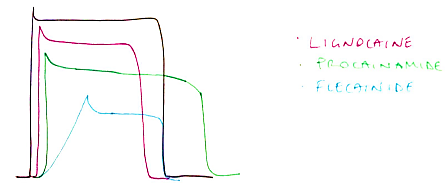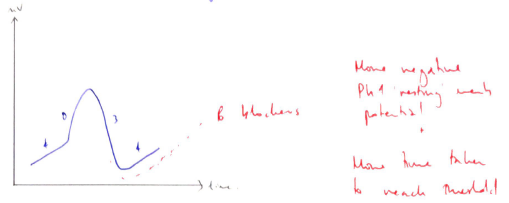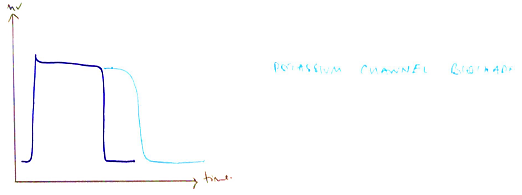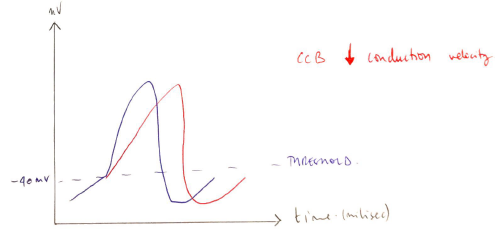G7iii / 16B21: Classify anti-arrythmic drugs by mechanism of action, giving examples of each (75 marks). Describe the electrophysiological and ECG effects of sotalol (25 marks)
16B21: Exam Report
Classify anti-arrhythmic drugs by mechanism of action, giving examples of each (75% of marks). Describe the electrophysiological and ECG effects of sotalol (25% of marks).
88% of candidates passed this question.
Most answers displayed a good knowledge of the Vaughan Williams classification, classes I to IV and the relevant electrophysiological characteristics of the classes.
Answers should also have included mention of other antiarrhythmics, such as digoxin, magnesium and adenosine. The second part of the question required comment about K ion blockade and its effects. It was helpful to mention prolongation of QT and risk of torsade. Most answers omitted reference to its being a racemic mixture, with different actions of the isomers.
G7iii / 16B21: Compare and contrast the mechanism of action, pharmacokinetics and adverse effects of digoxin and sotalol
- Arrhythmia = abnormal rate, generation, propagation of an AP
- Caused by:
- Abnormal PM activity
- Abnormal impulse propagation
∴ Antiarrhythmic:
- ↓ectopic PM activity
- Modify conduction
By altering:
- Slope Ph 4: β-blockers, adenosine, ↑vagal tone
- Threshold AP: Na+ channel blockers, CCB
- AP duration: Na+ channel blockers, K+ channel blockers
- Maximum diastolic potential: adenosine by hyperpolarisation

V – W classify antiarrhythmic in groups based on electrophysiological characteristics → based on micro-electrode studies
Class
I
SODIUM CHANNEL BLOCKERS
Example
IA – PROCAINAMIDE
IB – LIGNOCAINE
IC – FLECAINIDE
Mechanism of Action
Moderate Na+ channel block, ↑refractory period
Weak Na+ channel block, shortens AP
Strong Na+ channel block, no effect refractory period
Class
II
β-BLOCKERS
Non-selective
Selective
Intrinsic sympathomimetic activity
Example
PROPANOLOL
METOPROLOL
LABETALOL
Mechanism of Action
Antagonises effects of catecholamines at β receptors
In heart: – CHRONO, – DROMO, -INOTROPY
↓slope Ph 4 = more time to reach threshold = ↓discharge rate
Class
III
POTASSIUM CHANNEL BLOCKERS
Example
AMIODARONE
SOTALOL
Mechanism of Action
Blocks K+ channels
Prolongs refractory period of all cardiac time
Broad spectrum: blocks Na+ channel, K+ channel, Ca2+ channel & α + β adrenoreceptors
Class
IV
CALCIUM CHANNEL BLOCKERS
Example
DIHYDROPYRIDINES
BENZOTHIAPINES
PHENYLALKYLAMINES
Mechanism of Action
→ NIMODIPINE → Block Ca2+ channel of arteries
→ DILTIAZEM → AV node → inhibits inward Ca2+ current (↓rate conduction AV node)
→ VERAPAMIL → AV node → inhibits inward Ca2+ current (↓rate conduction AV node)
Class
OTHER
Example
Mechanism of Action
DIGOXIN
- Activates vagal nuclei = ↑ activity
- Inhibits Na/K/ATPase = RMP becomes less negative 2° ↑intrac. K (depol easier); AP shortens 2° ↑K conduction
ADENOSINE
A1 receptor on SA node → stimulates adenosine sensitive K+ channel → ↑K conductance = hyperpolarises – VE DROMOTROPY
MAGNESIUM
- Co-factor Na/K/ATPase
- L-type Ca2+ channel antagonist ECG prolongs R:R, ↑PR interval
- ↑AV conduction time
Sodium Channel Blockers
- Inhibit Fast Na+ channel of fast AP cells
- ↓slope of Ph 0
- ↓amplitude AP
- ↓conduction velocity (negative dromotrope) so that there is slower transmission of AP
→ Subdivided based on duration of AP (effect on refractory period)
IA – Procainamide
- Moderate Na channel block
- ↑refractory period → lengthens AP
IB – Lignocaine
- Weak Na+ channel block
- Shortens AP
IC – Flecainide
- Strong Na+ channel block
- No effect refractory period
Na+ channel block: IC > IA > IB
Lengthen AP: IA > IC > IB (decreases)

Beta Blockers
- Competitive antagonists of β1/β2 adrenoreceptors
- Antagonise effects of catecholamines
- ↓slope of Ph 4 = more time to reach threshold = ↓discharge rate

- – VE CHRONO, DROMO, INOTROPY
↓myocardial O2 consumption
Potassium Channel Blockers
- Block K+ channels responsible for repolarisation
- Prolong AP
- This ↑effective refractory period
- On ECG → prolongs QT interval

Calcium Channel Blockers
- Class 4 antiarrhythmics
- Diverse & structurally unrelated
- All block Ca2+ channels
- Classified on basis of CHEMICAL STRUCTURE
Dihydropyridines → Nimodipine
- Block Ca2+ channel of peripheral arteries
- Via extracellular modulation of Ca2+ channel
- Prevents Ca2+ entry into smooth m. cell
Benzothiapines → Diltiazem
- Intermediate between the other 2
- Predominate effect = AV NODE
- Inhibits inward Ca2+ current
- ↓rate conduction of AV Node → ↑PR interval
Phenylalkylamines → Verapamil
- Predominant AV Node, SA Node
- Physically occludes Ca2+ channel
- ↓rate conduction → ↑PR interval

Sotalol: Electrophysiology & ECG Effects
- Inhibits potassium channels
- Prolongs repolarisation
- Lengthens effective refractory period
- Lengthens QT interval
- ↓automaticity
- Slows AV conduction
- Β-blocking → competitive antagonist of β1 & β2 receptors
ECG: ↓HR, QT prolongation
- Author: Krisoula Zahariou